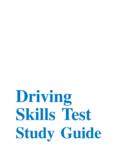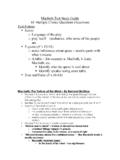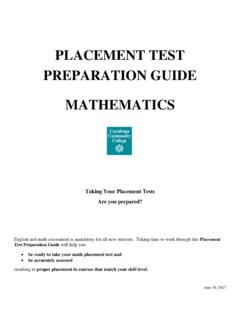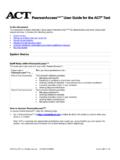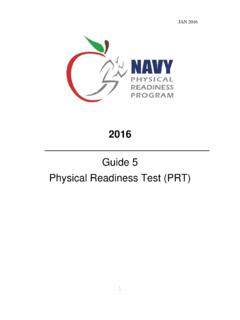Transcription of Public Safety Communications Pre-Employment Test ...
1 Public Safety Communications Pre-Employment Test Preparation guide The computerized CritiCall Pre-Employment test used by this agency measures underlying skills and abilities a person needs to possess prior to any training they might receive if they are hired as a Public - Safety dispatcher and/or calltaker, including the ability to effectively navigate and use a computer. Because of this, a test taker does not need to possess any specialized dispatcher/calltaker knowledge or training to be able to read, understand, or answer the test items. The following information is designed help a future test taker to prepare for the CritiCall testing process. General Notes Be sure to follow all of the instructions provided during the test. Practice test items are offered before each section of the test to help you understand how you should respond during that section.
2 Scores from the practice items are not included in your final test score. You are not required to take the practice items and you will be given an opportunity to bypass them during the test if you wish. During the test you will likely be required to listen to spoken information heard over a headset and then must use that information to answer questions or input data. You will also likely have the ability to adjust the volume of the information you hear over the headset. Many test takers find it helpful to have the computer's keyboard Num Lock (number lock) function turned on when taking the test. See for details. Do not be surprised when the computer allows you to enter information during many parts of the test using only UPPER case letters. This mimics computerized dispatcher systems, which also limit a dispatcher to enter information in only UPPER case letters.
3 You will be penalized if you skip any questions during the test (unless you are informed otherwise during the instructions for that portion of the test.). You may need to use scroll bars that might appear on the right side of the computer screen during testing so that you can view those parts of the screen that might be hidden. Copyright 2013 Biddle Consulting Group, Inc. 1. At some points during the test you may need to select the correct response by clicking your mouse on a box to the left of your choice, or by pressing the A, B, C, or D key on the keyboard. Scroll A check mark indicates your choice during Bar multiple-choice questions. In this example, the check (Move mark next to alternative B ( Green ) was placed by up and either moving the pointer over the small box to the down to left of the letter B and clicking once, or by entering view).
4 The letter B on the keyboard. You can change your response as many times as you wish before you move on to the next test item by either clicking on a different box or by entering a different letter. Decision rules to be followed during testing IMPORTANT! One of the important abilities needed by a Public For purposes of this test you should use Safety communication's employee is the ability to only the four decision rules shown below make decisions based upon structured rules. when responding to emergency message items during the test. Do not During the test, you will be asked to quickly and rely on any prior knowledge about either accurately indicate which type of agency ( , this agency or any other Public - Safety Police, Fire, Emergency Medical Service, or Public agency when responding to those items.)
5 Utility Company) should be dispatched to the scene of an incident according to the rules listed below. You should read and learn these four rules before taking the test. Experience has shown that the better an applicant knows these rules, the better they will perform during the decision- making portions of the test. Police Police Department should be dispatched when someone is attempting or threatening to physically harm another person, or has actually physically harmed another person, or when a person causes or is in the process of causing harm to another person's property. Fire Fire Department should be dispatched when there are the immediate signs of a fire in progress (such as flames or smoke), when a fire alarm is sounded, or when a person who is trapped or confined needs to be rescued or released.
6 EMS. Emergency Medical Service should be dispatched when there is an emergency medical condition requiring intervention by medically trained personnel. CONTINUED ON NEXT PAGE! Copyright 2013 Biddle Consulting Group, Inc. 2. CONTINUED FROM PREVIOUS PAGE. Utility Public Utility should be dispatched when there is a problem associated with malfunctioning or broken Public water systems, electric power systems (including, but not limited to, electrical power lines, streetlights, and traffic signals), natural gas systems used for home heating, or blocked sewer drainpipes. Examples: Based upon the decision rules shown above, if you were given the scenarios of: Man is throwing rocks in an attempt to hurt children, you should select POLICE as the correct response since the man was attempting to physically harm another person.
7 Electrical power lines knocked down during a severe hail storm, you should select UTILITY as the correct response because there is a problem with broken or malfunctioning electrical power lines. Please note that sometimes you will be asked to respond to emergency-message test items while performing other tasks on the computer. For this reason you will need to be reasonably proficient at navigating and using a computer in order to perform both tasks as the same time. To make your selection as to which of the four types of agencies should be dispatched in response to the emergency response messages that will appear on the screen during the test you will be required to: Move the computer's cursor over one of the four symbols (indicating Police, Fire, EMS, or Utility Company) (an example of the four symbols as they appear during the test is shown to the right) and left-click the mouse once to make your choice.
8 (The example to the right has the cursor placed over the Fire . symbol). Note: Throughout the test you should use only single clicks of the left mouse button. You will have only 15 seconds to respond to each of the emergency messages that appear on the screen during the test. Credit will not be given if an incorrect agency is dispatched or if your response is not made within the 15 seconds after the emergency message first appears. Entering information into the correct fields during the test Communication Center employees must be able to accurately enter information they hear into the correct fields on the computer. The figure below shows the location of the fields that will appear on the computer screen during the test. Copyright 2013 Biddle Consulting Group, Inc.
9 3. You can move from field to field by using the computer's mouse. Simply left-click the cursor in the field you wish to enter information into. You can also press the Tab key or the down-arrow ( ). key to move the cursor to the appropriate field. The Shift + Tab keys or the up-arrow ( ) key moves the cursor in the opposite direction. Note that the side-to-side arrow keys ( ) on the keyboard will not move the cursor during the CritiCall test. Note: The cursor always begins in the Last Name field whenever a new set of empty fields appears on the screen. The sequence the cursor moves as you press the Tab key or down- arrow ( ) key is as follows: Last Name; First Name; Telephone; Address; City; Zip; Vehicle Identification Number; License Plate; Driver's License (where it stops).
10 The cursor will NOT. move if you press the Tab key or down-arrow ( ) key while the cursor is in the Driver's License field. Finally, you can also move to a specific field by pressing the letter key that is underlined on the screen for that field (such as L in Last Name) while simultaneously pressing down the Alt key. For example, if you press down on the C key and the Alt key at the same time, your cursor will move directly to the City field. (See below for all of the field shortcuts). Alt + L = Last Name Alt + Z = Zip or Postal Code Alt + F = First Name Alt + V = Vehicle Identification Number (also called a VIN). Alt + T = Telephone Alt + P = License Plate Alt + A = Address Alt + D = Driver's License Alt + C = City Other Skills and Abilities That May be Measured During the Test The following is a list of some of the abilities that may be measured during the test.




